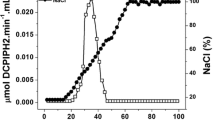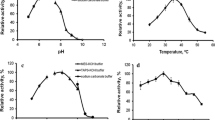Abstract
Penetration of glucose into cells of several extremely halophilic archaebacteria of the Halobacterium and Haloferax genera (Halobacterium saccharovorum and Halobacterium salinarium, Haloferax volcanii and Haloferax mediterranei) has been studied. Some characteristics of transport systems of carbohydrate-utilizing halobacteria Halobacterium saccharovorum, Haloferax mediterranei and Haloferax volcanii (pH and temperature optima, stereospecificity, kinetic parameters) have been determined. Inability of H. salinarium cells for active glucose transport has been shown. The dependence of glucose transport on the Na+ ions gradient (on the whole cells and membrane vesicles) has been demonstrated. Cells or membrane vesicles of carbohydrate-utilizing halobacteria grown in media containing this sugar indicated the activation of glucose transport, whereas cells grown in media without sugars did not. This fact has allowed us to conclude that corresponding transport systems are inducible.
Similar content being viewed by others
References
FeinJE, MacLeodRA (1975) Characterization of neutral amino acid transport in a marine pseudomonad. J Bacteriol 124: 1177–1190
GonzalesC, GuitierrezC, RamirezC (1978) Halobacterium vallismorits sp. nov., an amylolytic and carbohydrate-metabolizing extremely halophilic bacterium. Can J Microbiol 24: 710–715
HartreeGF (1972) Determination of protein: a modification of the Lowry method that give a linear photometric response. Anal Biochem 48: 422–427
IvanovskiRN, KarsanovVV (1982) Succinate uptake by Thiocapsa roseopersicina and Rhodospirillum rubrum. Mikrobiologiya 51: 230–235
JavorB, RequadtC, StoeckeniusW (1982) Box-shaped halophilic bacteria. J Bacteriol 151: 1532–1542
JuezG, Rodriguez-ValeraF, VentosaA, KushnerDJ (1986) Haloarcula hispanica sp. nov. and Haloferax gibbonsii sp. nov. Two new species of extreme halophilic archaebacteria. Syst Appl Microbiol 8: 75–79
MacDonaldRE, LanyiJK (1975) Light-induced leucin transport in Halobacterium halobium envelope vesicles: a chemiosmotic system. Biochemistry 14: 2882–2889
MacDonaldRE, GreenRV, LanyiJK (1977) Light-activated amino acid transport systems in Halobacterium halobium envelope vesicles: role of chemical and electrical gradients. Biochemistry 16: 3227–3235
MidgleyM, DawesE (1973) The regulation of transport of glucose and methyl-α-glucoside in Pseudomonas aeruginosa. Biochemistry 132: 141–154
OrenA (1983) Halobacterium sodomense sp. nov., a Dead Sea Halobacterium with an extremely high magnesium requirement. Int J Syst Bacteriol 33: 381–386
PimenovNV, SeverinaLO, PlakunovVK (1986) Glucose and galactose utilization by extreme halophiles during their growth and pigment production. Microbiology 55: 271–275
PimenovNV, SeverinaLO, PlakunovVK (1987) Some characteristics of glucose transport in the extreme halophilic bacterium Halobacterium mediterranei. Microbiology 56: 571–575
PimenovNV, SeverinaLO, PlakunovV (1988) Possible mechanisms of glucose and glucose-6-phosphate uptake by cells of extreme halophilic cocci. Microbiology 57: 577–581
Rodriguez-ValeraF, Ruiz-BerraqueroF, Ramos-CormenzanaA (1980) Isolation of extremely halophilic bacteria able to grow in defined inorganic media with single carbon sources. J Gen Microbiol 119: 535–538
Rodriguez-ValeraF, JuezG, KushnerDJ (1983) Halobacterium mediterranei sp. nov., a new carbohydrate-utilizing extreme halophile. Syst Appl Microbiol 4: 369–381
SeverinaLO, PimenovNV (1988a) Glucose metabolism in extreme halophilic archaebacteria. Microbiology 57: 152–157
SeverinaLO, PimenovNV (1988b) Glucose metabolism in Halococcus morrhuae. Microbiology 57: 718–722
TindallBJ, RossHNM, GrantWD (1984) Natronobacterium gen. nov. and Natronococcus gen. nov. Two new genera of haloalcalophilic archaebacteria. Syst Appl Microbiol 5: 41–57
TomlinsonGA, HochsteinLI (1972) Isolation of carbohydrate-metabolizing extremely halophilic bacteria. Can J Microbiol 18: 698–701
TomlinsonGA, HochsteinLI (1976) Halobacterium saccharovorum sp. nov., a carbohydrate-metabolizing extremely halophilic bacterium. Can J Microbiol 22: 587–591
TorreblancaM, Rodriguez-ValeraF, JuezG, VentosaA, KamekuraM, KatesM (1986) Classification of non-alkaliphilic halobacteria based on numericial taxonomy and polar lipid composition, and description of Haloarcula gen. nov. and Haloferax gen. nov. Syst Appl Microbiol 8: 89–99
Author information
Authors and Affiliations
Rights and permissions
About this article
Cite this article
Severina, L.O., Pimenov, N.V. & Plakunov, V.K. Glucose transport into the extremely halophilic archaebacteria. Arch. Microbiol. 155, 131–136 (1991). https://doi.org/10.1007/BF00248606
Received:
Accepted:
Published:
Issue Date:
DOI: https://doi.org/10.1007/BF00248606




